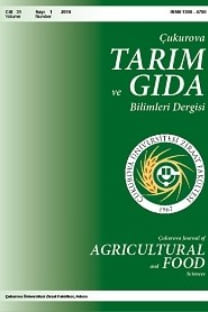Genetiği Değiştirilmiş Organizmalar ve Olası Riskler
Hızla artan dünya nüfusunun ihtiyaç duyduğu gıda miktarındaki artışla birlikte tarımsal alanda birim alandan daha yüksek oranda ürün elde etme temel hedef olmuştur. Aynı zamanda, dünyada biyoteknoloji alanında ortaya çıkan yeni gelişmeler genetiği değiştirilmiş organizmalarla (GDO) ilgili çalışmaların ve üretimin artışıyla sonuçlanmıştır. Dünyadaki üretimin çoğunu yapan ülkeler bu ürünlerin tamamen zararsız olduğunu iddia etmektedir. Ancak, bu ürünlerle ilgili net olmayan bazı konular, pazara denetimsiz ve etiketsiz sunulması gibi nedenler genetiği değiştirilmiş organizmaların üretimine tereddütlü yaklaşılmasında etkili olmaktadır. Bu çalışmada genetiği değiştirilmiş organizmaların doğrudan ve dolaylı yaratabileceği bazı sorunlara dikkat çekmek amaçlanmıştır
Anahtar Kelimeler:
Genetiği değiştirilmiş organizmalar, olumlu ve olumsuz yönleri, çevre, biyoçeşitlilik
Genetically Modified Organisms and Possible Risks
It is aimed that increasing food amount which is needed for rapidly increasing world population with having higher rate of yield from unit area at agriculture. At the same time, new developments occured at biotechnology has been concluded studies and production related to genetically modified organisms. Countries which are produced most of the gm yields claimed that these products were harmless completely. However, some unclear matters as putting up for sale to market uncontrolled and unlabeled type cause hasitation of genetically modified organisms. In this study, it is aimed that to focus on problems cause of genetically modified organisms directly and indirectly
Keywords:
Genetically modified organisms, favorable and unfovarable aspects, environment, biodiversity,
___
- Akçelik, M. (2004) Yaşam Gen Demek Değildir. Yaşam Bizimdir Dergisi, Temmuz 2004 s: 10-12.
- Azadi, H., Ho, P. (2010) Genetically Modified and Organic Crops in Developing Countries: A Review of Options Biotechnology Advances 28: 160-168 Security.
- CBD (2011) Convention on Biological Diversity. Cartegena Protocol on Biosafety. http://bch.cbd.int/protocol/background
- Costa-Front, M., Gil, J.M. (2009) Structural equation acceptence of genetically modified (GM) food in the Mediterranean Europe: A cross country study Food Quality and Preference 20: 399-409
- Critch, S., Holt, L., Kickham, P., Leney, J., Skalski, M. (2001) Background Paper on the Potential Negative Effects of Genetically Modified Crops on the Environment. Environmental Science Post-Graduate Programme, Capilano College, Canada. http://www.capcollege.bc.ca/programs/envsc/pdfs/fin algmc.pdf
- DeSantis, S., (2005) Mexico Genetically Modified Organisms Threaten Indigenous Corn. Zmagazine http://www.zmag.org/Zmag/articles/julaug0 2desantis.html 15:
- Defra (2011) Department of Environment, Food and Rural Affairs. Genetic Modification. www.defra.gov.uk/environment/quality/gm
- El-Lakany, M. H. (2004) Are Genetically Modified Trees A Threat To Forest? FAO Corporate Document Repository, Forestry Department, Rome.
- Endo, Y., Boutrif, E., 2000. Plant Biotechnology and It’s International Regulation-FAO’s Initiative. Livestock Production Science. s: 217-222
- FAO (2003) Weighing the GMO Arguments: Againts. http://www.fao.org/english/newsroom/focu s/2003/gmo8.htm Newsroom.
- FOE (2003) Biodiversity New UN Treaty Admits Potential http://www.foe.co.uk/campaigns/biodiversit y_stories/new_un_treaty_admits.html
- Gartland, K. M. A., Crow, R. W., Fenning, T. M., Gartland, J. S. (2003) Genetically Modified Trees: Production, Properties and Potential. Journal of Arboriculture, 29 (5): 256-266
- GMO Compass (2011) GM Crop Production. http://www.gmo-ompass.org/eng/agri- biotechnology/gmo-planting/194.docu .html
- Lang, C. (2004) Genetically Modified Trees-The Ultimate Threat. ISIS Report. http://www.i- sis.org.uk/GMFTUT.php
- McDonnell, L.M., Coleman, H. O., French, D.G., Meilan, Engineering Trees with Target Traits. Forest and Genetically Modified Trees. FAO Part 4, s: 77-122 S.D., 2010.
- Owusu, R. A. (1999) GM Technology in the Forest Sector: A Scoping Study for WWF- UK, 34 S.
- Pelletier, D.L. (2006) FDA’s regulation of genetically engineered foods. Scientific, legal and political dimensions. Food Policy 31: 570-591
- Petermann, A. (2004) GE Trees and Global Warming: The Myth of Carbon Offset Forestry. Global Justice Ecology Project.
- Sökmen, M. A. (2005) Genetik Yapısı Değiştirilmiş Bitkiler ve Bitki Koruma Amaçlı Kullanımı. OMÜ Ziraat Fakültesi Dergisi 20 (3): 105-109
- TÜRKTED, 2012. Türkiye Tohumculuk Endüstrisi Derneği. http://www.turkted.org.tr
- Uzogara, S.G. (2000) The Impact of Genetic Modification of Human Foods in the 21st Century: A review. Biotechnolohy Advances 18: 179-206
- Var, I., (2004) Genetiği Değiştirilmiş Organizmalar. 14 Ekim 2004, ÇETKO, 15 s.
- Williams, J. (2001) Australia State of The Environment Report 2001-Biodiversity Theme Report. Department of the Environment and Heritage, Australia. Wynberg, R., Jardine, C. (2000) Biotechnology and Biodiversity: Key Policy Issues for South Africa. Final Draft.
- Zarilli, S. (2000). International Trade in Genetically Modified Organisms and Multilateral Negotiations.
- Zarilli, S. (2005) International Trade in GMO’s and GM Products: National and Multilateral Legal Frameworks. Policy Issues in International Trade and Commodities Study. Series No: 29, NewYork and Geneva, 55 S.
- Zheng, Y. (2010) Research, Deployment and Safety Management of Genetically Modified Poplars in China. S: 135- 144.
- Zülal, A. (2003) Gen Aktarımlı Tarım Ürünleri. Bilim ve Teknik Dergisi 426: 38-43
- ISSN: 2636-7874
- Başlangıç: 1973
- Yayıncı: Çukurova Üniversitesi
Sayıdaki Diğer Makaleler
Genetiği Değiştirilmiş Organizmalar ve Olası Riskler
Pembe ÇÜRÜK, Tolga İZGÜ, Metin KOÇAK, Mehmet TÜTÜNCÜ, Ehsan TAGİPUR, Özhan ŞİMŞEK, Yeşim YALÇIN MENDİ, Ahsen I ÖZGÜVEN
Farklı Azot Kaynakları ve Seviyelerinin Medine Çiçeği (Gomphrena globosa)’nin Gelişimine Etkileri
Pembe ÇÜRÜK, Ayfer TORUN, Metin KOÇAK, Ayşegül BURGUT, Özlem YÜKSEL, Yeşim YALÇIN MENDİ
